
MAY CONTAIN NUTS

Search Shorpy
SHORPY ART

Framed or unframed, desk size to sofa size, printed by us in Arizona and Alabama since 2007. Explore now.
Join and Share
Ad-Free Shorpy
Shorpy is funded by you. Patreon contributors get an ad-free experience.
Learn more.

Recent comments
- Exclusive pump
- Details, Details
- What's that building to the left of the tower?
- Coal Barges
- Bromo-Seltzer
- Inner harbor
- The Basin
- What a headache!
- Giant stepladder?
- Baldwin 62303
- Baldwin VO-1000
- Cold
- No expense spared
- Tough Guys
- Lost in Toyland
- And without gloves
- If I were a blindfolded time traveler
- Smoke Consumer Also Cooks
- Oh that stove!
- Possibly still there?
- What?!?
- $100 Reward
- Freeze Frame
- Texas Flyer wanted
- Just a Year Too Soon
- WWII -- Replacing men with women at the railroad crossing.
- Yes, Icing
- You kids drive me nuts!
- NOT An Easy Job
- I wonder
Member Photos
The Shorpy
Print Emporium
Print Emporium
Search Shorpy
Search results -- 30 results per page
- S.S. Cabrillo: 1910
- ... lost coins offshore, too.
Glass Bottom Boat
Change Is Good The fellows standing in the rowboats gathered ... Posted by Dave - 07/26/2019 - 4:18pm -
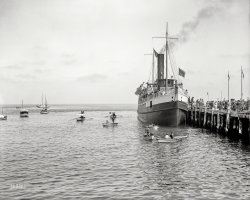
- Strolling in the Park: 1906
- ...
In the foreground pond r.l. we find a handsome pulling boat with a wineglass transom, possibly a "Whitehall boat". The boat with the flags seems to be a power launch. Best of all is the ... Posted by Dave - 04/07/2015 - 8:15am -
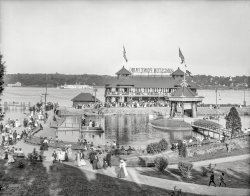
- Upper Chunkers: 1940
- ... the Molly Maguires is worth a visit, too.
She is not a boat "Chunker" was also a name for the canal boats that carried the coal ... Posted by Dave - 07/03/2017 - 1:58pm -
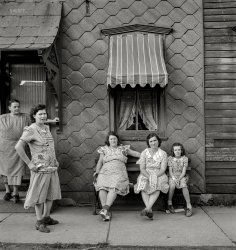
- Networking: 1905
- ... that slicker.
We're gonna' need a bigger boat! **cue Jaws music**
(The Gallery, Boats & Bridges, DPC) ... Posted by Dave - 08/21/2012 - 12:36pm -
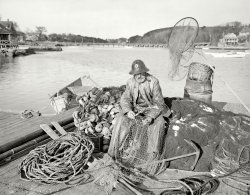
- Priscilla: 1901
- ... Photographic Company. View full size.
The Luxe Boat Heard about this steamship line from older relatives when I was a ... Posted by Dave - 06/03/2016 - 12:59pm -
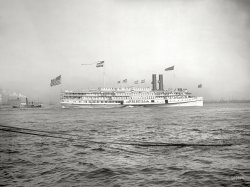
- Minnie and Topsy: 1962
- ... out near Gooseberry Island. In tow behind their boat is weekend visitor Dick Cowell, a former water-ski champion." 35mm ... Posted by Dave - 09/16/2023 - 11:24am -
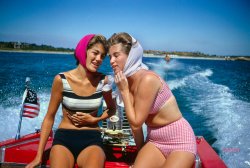
- Ducktail Trailer: 1936
- ... the car has the 200hp towing package.
Funny looking boat They must be talking about "Land Yachts."
(The Gallery, Cars, ... Posted by Dave - 08/18/2012 - 8:07am -
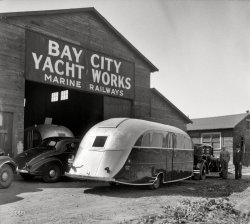
- River City: 1910
- ... at left foreground. It seems a lot heavier than a torpedo boat -- surely the weapon on top of the aft conning station is larger than the ... and explaining why Adam thought it might be a torpedo boat -- we're seeing only a small part of a 4-funneled craft. However, ... Posted by Dave - 10/12/2022 - 1:45pm -
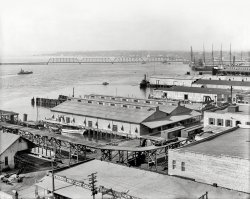
- Just Add Water: 1912
- ... built in the early 20th century.
I'm not a boat guy ... or a fence guy, or a train guy, but this is quickly becoming ... Posted by Dave - 03/09/2018 - 12:24pm -
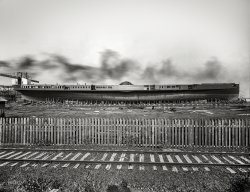
- The Tenement: 1905
- ... 1800s up until the Depression known as the "Perfect."
Boat model To the left of the doorway is a half-model of a boat hull with a centerboard. It's a technical rather than a decorative object ... Posted by Dave - 07/23/2012 - 3:40pm -
![The Tenement: 1905 Circa 1905. "New York tenement." With a number of tiny inhabitants in evidence. Dry plate glass negative, Detroit Publishing Company. View full size.
Typical catWon't hold still for a photo!
Lord of the FliesSee the little black kitten in front of the stove? Hopefully he (she?) won't get a paw in either of the two sheets of flypaper, one on each table. Plenty of flies to keep Kitty entertained.
The dressing tableNotice the hat pins, scent bottles and other such items on the dressing table. This tenement dweller did not leave home unadorned!
Photo on shelfLooks like a National Guard Company group photo
Not your typical tenementWhile we can't quite see through the window to the left of the oval bedroom mirror, it is evident from the amount of sunlight coming through that the window opens to the outside. It's a sign that this tenement is of higher quality (and rent) than most. Tenement bedroom windows usually opened onto narrow airshafts that admitted dim light and very little fresh air.
Also, many tenement dwellers in 1910 would have been first-generation immigrants, mostly from southern or eastern Europe. If immigrants, the occupants of this tenement are at least knowledgeable enough in English to be reading an English-language newspaper. Again, if they're immigrants at all: the picture of soldiers looks like it could have been from the American Civil War, more than a generation in the past when this picture was taken.
Basement catThe first known photo of Basement Cat emerging from the shadows.
Tenement 1910Million-dollar condo 2010.
Evening JournalThe New York Evening Journal was a daily (except Sunday) published by William Randolph Hearst from 1897 to 1909. The paper was sold in 1909 and ceased publication in 1911.
Tenement MuseumIf any Shorpsters find themselves in NYC, they can visit the Tenement Museum and see a re-creation of a tenement much like this one. It is a fascinating place with, yes, some old photographs. It is on Orchard Street on the Lower East Side.
RemodelThe disk high on the wall is a decorative cover used to plug an opening where an old flue pipe went through the wall, probably from a coal stove. Judging from the matching cover in the bedroom, the flue went horizontal for a while before heading up and out. The cover had spring clips on the back that snapped into the circular opening.
Anyone make out what's in the mirror?
Location, Location, LocationThe photo doesn't let us know where in NYC it is. 1910 tenements usually conjure an image of the Lower East Side, a neighborhood of immigrants. In this picture, which could be in Midtown, Yorkville or the Upper West Side or even Harlem, we have reasonable living quarters for 1910. The newspaper on the table appears to be in English. One picture on the wall show a Military unit, possibly a Spanish-American or Civil War Unit that a resident or relative served in. A tenement building was and is a way of life in many American Cities. Many remain in the poorer neighborhoods today, however the very upscale Upper East Side of Manhattan has them on almost every block east of Madison Avenue. A few are run down, but most are well kept and the monthly rents, where they are not controlled, are in the multiple thousands. The vacancy rate is around 1%.
IronIt is faint in the photo, but it appears there is a flatiron leaning against the baseboard behind the corner of the stove.
What is it?Can anyone tell me what the woven wooden object is that in propped up on the wall shelf?
[A fan. - Dave]
Home Sweet HomeAs somebody who lives in a 274-square-foot tenement from 1871 in the West Village, I find this photo wonderfully revealing. My home as been updated (in 1934), but still retains a lot of quirks. This shot is such a wonderful view into the personal lives of folks that lived in homes like my own. I can only imagine how warm the home must have been in the summertime with the cast iron stove and gas lighting.
More photos like this please!
The Evening Journal revisitedSince the old New York Journal-American was my late father's favorite newspaper, I'm going to have to quibble with Old Molly's history of the New York Evening Journal. The history account I found has William Randolph Hearst publishing both the morning American and the Evening Journal in New York from 1895 until they were combined in 1937 into the afternoon Journal-American, which continued as a Hearst publication until 1966, when it was merged with the old World-Telegram and Sun and the Herald-Tribune into the very short-lived World-Journal-Tribune.
Love the Rohrshach tableclothNot about to divulge the things which popped into my imagination by that design along the bottom edge. Okay, one. I see a bearded gent with spectacles peering through an arbor.
Another thought came to mind while examining the photos in the room. Which was the chance we just might come across a Shorpy photo hanging on the wall in another Shorpy photo. I'm too old to use the phrase "that would be so cool," but that would be apt.
Quibble acceptedOld Molly agrees with the Tipster and stands corrected. Through mergers and various name changes, the paper survived until relatively recent years.
Yarn swift The thing reflected in the mirror appears to be a yarn swift, or winder. The bag would be used to store it.
Those are definitely flatirons (or, as they are known down here in the South, "sad irons," as it was a sad day when you had to use them because no matter the weather a lot of heat was involved).
Great photo with lots of history which is somewhat lost except in museums or as one contributor pointed out a Tenement tour in New York.
Stove Update A little Google research indicates my earlier thought the stove was a conversion may have been wrong. The Gem City Stove Company in Dayton, Ohio, produced a gas stove from the late 1800s up until the Depression known as the "Perfect."
Boat modelTo the left of the doorway is a half-model of a boat hull with a centerboard. It's a technical rather than a decorative object and makes me suspect that someone in the tenement was a boatbuilder.
It's definitely a well kept room and a superior tenement, but I bet that on a hot day it SMELLED.
Basement CatI often wondered where Basement Cat got his start. Now I know. (I wonder if anyone else got that).
Lewis Hinemust think everyone lives a wealthy life. This apartment looks clean and lovingly "decorated" to the best of the tenants' ability. I don't think it is all that bad!!
[Perhaps, but this is not a Lewis Hine photo. And did anyone say it was bad? - Dave]
The Gift of the MagiI have never felt closer to O. Henry than at this moment.
Flash of memorywhen I noticed the wooden match holder next to the stove! Haven't seen one of those in a kitchen since the '50s.
What are those pipes for?Does anyone know what use the pipes from above have? They might be a fire suppressant, but I am not sure.
[The "pipes" are gas light fixtures. - Dave]
Tenement DefinedIt's a little puzzling how the word "tenement" came to imply poverty or deprivation. I suppose the constant association by Lewis Hine and others of the word to their photographs of dire poverty would do the trick.
Technically, the word tenement, as defined by New York City anyway, means any building that houses three or more unrelated families. The doorman buildings on Park Avenue are, by strict definition, tenements as well.
GaslightDid one have to climb a ladder or stand on a high chair whenever they wanted to light the gas jets?
PerfectI actually have an ad for this very oven - posted in a Dayton publication from 1904.
It was placed by the Dayton Gas Light and Coke Company.
COKE COKE COKE
SMOKELESS FUEL
Recommended by all Range and Furnace Manufacturers as being the cheapest, cleanest and most reliable fuel.
Orders received at the Dayton Gas Light and Coke Co's Office
etc. etc.
Try and visitGeezerNYC submitted the comment that shorpsters can visit the Tenement Museum in NYC and see a recreation. In fact,you can enjoy an in depth online recreation and 360 degree walkthroughs of these wonderful tenements at http://www.tenement.org
The site is dedicated to the stories of immigrants who lived in 97 Orchard Street, a tenement built in 1863 on Manhattan's Lower East Side. There are TONS of picture archives, a virtual tour, collections, first hand accounts of several families that lived there and LOTS more. I've visited it several times and I love it every time. I'm sure it is NOTHING like taking an actual walking tour of the tenement museum but it's as close as I can get for now. I suggest that everyone check this out. I'd also like to say that the comment such as how it had to have "smelled" in the heat of summer, etc. just bummed me out. So it may have smelled. so what. Many of these people struggled and busted their rear ends like no tomorrow just to get bread on the table and clean clothing to wear, to put shoes on their kids feet and on and on. We truly can't even begin to compare our lives today to the lives of the vast majority of those who lived in these tenements. They made the best of what they had. It was home.
PipesThe pipes above the stove are gas pipes. Note the shut-off valves on the pipes.
(The Gallery, DPC, Kitchens etc., NYC)](https://www.shorpy.com/files/images/4a20824u.thumbnail.jpg)
- Kin Tuk: 1940
- ... negative by Marion Post Wolcott. View full size.
Boat Notes This looks a lot like my Old Town High Water from 1929 -- a canoe ... Posted by Dave - 05/28/2019 - 9:28pm -
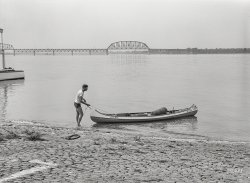
- Excursionists: 1901
- ... on the season I wouldn't want to be on the bow of that boat in January.
There's a reason for the clarity The reason it's ... a hat on I'd have been ostracized, or worse thrown off the boat. Even 100 years later, the no hat thing is kind of creepy. I guess it ... Posted by Dave - 08/02/2012 - 3:15pm -
![Excursionists: 1901 Circa 1901. "Sidewheeler Tashmoo." Our fourth look at the popular excursion steamer, which plied the Detroit River between Detroit and Port Huron. 8x10 inch glass negative by Lycurgus S. Glover, Detroit Publishing Co. View full size.
Up close and personalApproximately two thirds of the 55 mile trip from Detroit to Port Huron takes place on the narrow Detroit and St. Clair rivers, giving the passengers a close-up view of the goings-on on both the U.S. and Canadian shores and the passing ships. The 20 mile crossing of Lake St. Clair (deepest parts only 20 feet except for the shipping channel) gave the passengers the thrill of seeing the shore recede into a thin dark line for a reasonable period of time. This probably gave many a swain the opportunity to calm the fears of his fretful companion during this part of the trip.
Back to the FutureThis is where Shorpy excels. The clarity of the HD version is phenomenal. I wish I could get my pictures this sharp and it's 109 years later.
Sidewheeler?Great picture! Don't think that it's a sidewheeler though, appears to have either an enclosed sternwheel, or propeller(s).
[If you look closely at the photo, you'll see that the Tashmoo was indeed a sidewheeler. - Dave]
Depends on the seasonI wouldn't want to be on the bow of that boat in January.
There's a reason for the clarityThe reason it's so clear is the glass negative was a full 8 x 10 inches, whereas our consumer level cameras use 35 mm film or digital sensors smaller than that. More negative area = much better resolution. That being said I am consistently blown away at the detail one can see in these old photos!
Re: ClarityWell, the photographers of 100+ years ago were working with vastly different equipment. Instead of a fast f/2.8 lens and a half-inch sensor, they had smaller apertures, perhaps f/22 or higher, on a nearly 13-inch diagonal plate!
At 3600 dpi (not unreasonable for silver emulsion), that's nearly a gigapixel image.
Hats OffI wonder if I showed up without a hat on I'd have been ostracized, or worse thrown off the boat. Even 100 years later, the no hat thing is kind of creepy. I guess it creeped out JFK enough for him to almost singlehandedly put the monolithic practice into the dustbin of history (without even realizing it).
Tashmoo ParkThe main stop the boat made along the run from Detroit to Port Huron was at Tashmoo Park, an amusement area on Harsen's Island in the St. Clair Flats at the northern end of the lake. In fact, the park was really the reason for the existence of the excursion boat run. My grandparents took this boat to the park several times while they were courting, and later took my very young father there with them. Eventually, they bought a summer cottage on the island not far from where the amusement park once stood.
Boat HouseThe upper structure today is a well known summer home on the Detroit River in Amherstburg, Ontario.
(The Gallery, Boats & Bridges, DPC)](https://www.shorpy.com/files/images/4a14840a.thumbnail.jpg)
- Catalina 1940's
- ... photos of this trip. View full size.
Glass Bottom Boat This is not the SS Catalina, but one of the paddle-wheel glass bottom ... Posted by mhallack - 07/24/2009 - 4:44pm -
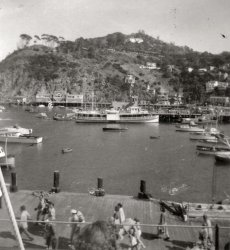
- Life Savers: 1908
- ... might run through the two metal rings on top of the boat to keep it on course. The men at the right of the photo are pulling in the boat using one of the control lines; the other would go out to the disabled ... Posted by Dave - 08/21/2012 - 5:54pm -
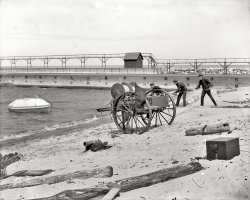
- From All of Us: 1921
- ... are based on those listed in 1920 census plus one.]
Boat Ornaments! I love the viking boat ornaments! I feel inspired to make some for my own tree.
Charlie ... Posted by Dave - 04/29/2014 - 1:44pm -
![From All of Us: 1921 Washington, D.C. "Dickey Christmas tree, 1921." Our annual holiday card featuring the family of lawyer Raymond Dickey, who has a decade's worth of Christmases preserved in the archives of the National Photo Co. View full size.
Different treesWow. It never ceases to amaze me how different Christmas trees looked back in the day. I don't mean the decorations, I mean the actual shape of the tree. Is it because they were just chopped from somewhere by the homeowners? Or maybe there is a species that has been developed for mass consumption today? I don't mean any disparagement on Mr. Dickey's tree because it looks like it was lovingly decorated, which is the whole idea. It's just that the shape is so strange to me and I've seen it in other pictures of that era that have been posted here that I'm curious.
Conical ChristmasThis photo makes me wonder - When did the current "pointy triangle" Christmas tree become popular?
Did a bill collector just enter the room?Again, a scrawny tree with no lights. Doesn't look like a happy family, and what could they be staring at?
[Look again. There are lights all over this tree. - Dave]
Perfection is relativeI've observed that in old photos of plain and poorly shaped women as well as poorly shaped Christmas trees, many viewers raise the subject of appearance. We had trees like this when I was young, usually because Dad always got one that was way too tall and we had to cut off to fit it in the room. We had one as recently as about 20 years ago that looked like a giant tumbleweed, rather shapeless and sparse. However, in defense of such trees, my son pointed out that such spareness of greenery made the ornaments much more important, visible and spotlighted the outstanding beauty of decorations such as these, while the lush, bushy trees often obscure the ornaments. I notice that this year there is a "Charlie Brown Tree" for sale which is basically a very sparse branch on a thin, wispy trunk with only one ornament on the single branch, as in the cartoon. As kids, we loved our skimpy, roundish, scanty Christmas tree (just as God made it) and found it magically beautiful. Perhaps growing up and becoming "sophisticated" makes us see faults instead of beauty? Just look at these magnificent ornaments. May your best ever Christmas holiday be exceeded this year. May Shorpy continue to gain fans and prosper.
TriangularIt's spruces that are conical. This looks like pine.
The smell of ChristmasAh, what wonderful holiday memories; the aroma of evergreen needles and Daddy's cigar smoke in my face.
Reflections on an OrnamentDo you have a bigger version of the bauble above the girl's head? I'd love to see the rest of this room (and maybe the photographer?).
Ornaments of days gone byChristmas tree shots like this always throw me into a temporal disconnect; these are the exact kind of ornaments I grew up with in the 1950s.
And I'll bet this tree looked fantastic in color and in normal, rather than exploding flash powder light.
Christmas VacationThis is definitely a Clark Griswold tree. I only wonder where cousin Eddie is.
Modern Tree TastesThat tree is fabulous.
I think back in the day, especially if you didn't live somewhere fairly close to a supply of ideal, cone-shaped firs or cedars, you pretty much settled for whatever healthy-looking pine or cedar-like tree you could find.
Also, keep in mind that today's Christmas tree farms prune the trees every year to make sure they maintain the ideal cone shape. Let 'em run wild and they wouldn't be so perfect, and probably more sparsely limbed.
When I was a kid ('70's), before there were any tree farms around, we would just go out in some of our or a relative's woods & find a young juniper & pull it out of the woods.
Love this treeThis is more than a Christmas tree. This is Christmas tree as art installation. I love the fact that it nearly takes over the room and that there is room to breathe between the branches that allows the ornaments and ropes of glass balls to be draped and displayed in all their glory.
This is the kind of tree my grandparents always had--very big and wide and decorated with the exact same ornaments. The only thing missing is Angel Hair (was it actually fiber glass?). My grandmother went through a big angel hair period before she moved on to tinsel.
Too bad all the trees nowadays look exactly the same-perfectly shaped and boring, and too thick to truly decorate and dress to the nines.
Alice Dickey ThompsonIts a bit hard to believe from this photo, but the teenager on the right, young Miss Alice Dickey, is destined to be the Editor and Publisher of Seventeen Magazine and Executive Editor of Glamour Magazine. I'm still hunting for a later photo of her.
Some Links from the web:
Time Magazine, 1949
Time Magazine, 1950
Women's periodicals in the United States: consumer magazines
Washington Post, Apr 2, 1940
Rites for Raymond B. Dickey,
Lawyer, to Be Held Tomorrow
Funeral rites for Raymond B. Dickey, 62, dean of faculty of the Washington Chapter of the American Institute of Banking and a prominent attorney, will be at 2 p.m. tomorrow at Deal funeral home, 4812 Georgia avenue northwest. Burial will be in Cedar Hill Cemetery
...
A native of Harpers Ferry, W. Va., Mr. Dickey was educated at Georgetown University where he was awarded an LL.D. degree in 1899 and his LL.M. the following year.
At the time of his death he was general counsel for the Civilian Conservation Corps. For many years he taught the bills and notes course at the banking institute.
With his son, J. Maxwell Dickey, he maintained offices in the National Press Building. He made his home at 1702 Kilbourne street northwest.
...
Besides his son, J. Maxwell Dickey, he leaves his wife, Mrs. Rose M. Dickey; two other sons, Granville E., chief statistician of the Civilian Conservation Corps, and Raymond D. Dickey, of Arlington County, a public relations counsel; and a daughter Mrs. Alice D. Thompson, of California and New York City, the editor of Glamour Magazine.
According to the 1920 Census, those pictured here are:
Raymond B., 43
Rose M., 40
Alice E., 13
John M., 9
Raymond R., 3
The census also lists an older son, Granville E., 18. [Note: ages are based on those listed in 1920 census plus one.]
Boat Ornaments!I love the viking boat ornaments! I feel inspired to make some for my own tree.
Charlie Brown Christmas treeI still get flack over this straggly tree, but it remains my favorite, because I took my three-year-old son into the woods and he helped me select cut, haul, erect and decorate it.
Beautiful photo!I love this picture. The Christmas tree looks as though it's been lovingly decorated by everybody in the family without notions of "the perfect tree." As someone who is (not by choice) alone on Christmas, I wish I could join them!
OrnamentalismI recognize quite a few of these glass ornaments from our own trees of my childhood.
We had some of the Santa ones and quite a number of the various balls. As well as birds with the spun glass tails. My favorite was always the crane with the long neck and beak. They clipped onto the branch on a spring.
Over the years we lost many of them and the last went when a friend, well known for his clumsiness) was helping put up the tree and sat on the box of ornaments.
Who is that man in the ornament?Look at the silver ball over Alice's head. Looks like a man seated with a dog.
Clouded PupilsWhy are the pupils of the two bottom kids clouded? Maybe the shutter speed was just slow enough to get a blink in there?
[The "clouded" or "zombie" look is a characteristic of flash powder photography, where there was usually no mechanism for synchronizing the exposure and flash. The photo catches the subjects' eyes both open and closed because the exposure is slightly longer than it needs to be. With the advent of flashbulbs and electrical synchronization of shutter and flash, the exposure generally ends before the flash triggers the blink reflex. In the early days of "flashlight" photography, shutter speed wasn't a factor because there was no shutter, or the shutter wasn't used. The lens cap was removed from the camera, the flash was ignited, then the lens cap was replaced. - Dave]
Beginning to See the LightsI think the "Viking boat ornament" may have been a balloon with a sail, as in a Jules Verne illustration.
Thanks, Dave, I now see the lights—how could I have missed them?
Buety is In the eye of the beholderI don't think there is such a thing as a bad looking Christmas tree. I am often amazed by comments made to the contrary. Nowadays so many times the word "tradition" leaves little to the imagination. Some of the most memorable Christmas trees of my past looked a lot less ornate than this tree by far but they were perfect on our eyes. Back in the early 60's we used to string cranberries and popcorn to put on our tree.
[Something tells me you haven't seen Buety lately. - Dave]
Good Luck!I think I've spotted the Christmas Pickle!
"Village of the Damned," anyone?Even with an explanation, those kids are pretty creepy.
Tree Full of HeirloomsLet's hope the kids of these kids are still putting the same beautiful ornamants on their trees this Christmas.
Connections, connections...Alice probably edited the Glamour magazine seen hanging in the newsstand in last week's "Zines":
https://www.shorpy.com/node/7233
It's amazing how things here are connected.
I'll be darned. After reading the tip about Alice growing up to be an editor, I pulled out my trusty copy of Seventeen Magazine from November 1946 from my desk drawer (doesn't everyone have one stored there?)...and sure enough, there she was! What a cool connection.
Tree FarmingI'm not sure how long Christmas tree farming has been a business, but I suspect it wasn't during this family's lifetime. These days it can be profitable business, but while it isn't exactly regulated, with rules as to the sort of trees that can be grown, there are preferred types. According to the Ontario Ministry of Agriculture, Food and Rural Affairs, the preferred types are White Pine, White Spruce, Scots Pine, Balsam Fir, Blue Spruce and Fraser Fir. The trees are pruned for shape and to increase foliage density.
I suspect that none of this happened to this tree. Someone probably just went out into the woods and cut down the scraggly runt trees that didn't look like they'd ever amount to anything went it came to lumbering. Then they shipped them off to the city where they'd cost a pretty penny to the buyers and supplement the lumber company's bottom line. I'm guessing these folks got the best of what was available and were damned pleased to get it.
Not only does he smoke in the house,but he can't put it down for the Christmas photo.
I am assuming that the Dickey family had these made but didn't send them out in Christmas cards ...after all the invention of the refrigerator magnet was decades in the future.
Old Clothes?This is one of those photos you can look at in hi-def and notice more and more. This family is obviously prosperous -- it's a huge tree and elaborately decorated, if not in the current shape fashion,also note the train set-so WTH- Mom's in her oldest skirt with stuff crammed in her pocket,junior has holes in his stockings and something safety-pinned to the front of his shirt and the future glamour editor looks decidedly unglamorous. Even given the limitations of flash photography at the time, these people don't look happy,and even in 1921 people had plenty of experience with Kodaks and snapshots and knew how to smile for a picture. Here Mom looks deranged, Dad looks like he's threatening the terrified looking child on his knee, and the two older kids look like they can't wait to get out of there. Merry Christmas!
Shorpy on TVI did a double-take during last night's Daily Show with Jon Stewart. An altered version of this photo appeared during a segment entitled Obama's Socialist Christmas Ornament Program. Either it's a remarkable coincidence or someone at the Daily Show is reading Shorpy.
(The Gallery, Christmas, D.C., Kids, Natl Photo, The Dickeys)](https://www.shorpy.com/files/images/29741u.thumbnail.jpg)
- Little Kittens: 1941
- ... makes other hardships much easier to bear.
Bloody boat anchors freddy223 , the answer to your question is "between 40 and ... Posted by Dave - 01/17/2021 - 1:32pm -
![Little Kittens: 1941 March 1941. "Girls at trailer camp for defense workers. Ocean View, Virginia, outskirts of Norfolk." Medium format acetate negative by John Vachon. View full size.
Trying, but failingTo understand the gizmo attached to the bottom of the rear fender on the closest bike. It looks like there is one on the other bike, too.
[It's a kickstand. - Dave]
Well, of course it is. Pretty obvious. Thanks, Dave.
Sweet kidsThat girl in the back is beautiful. She could be a model. I wonder how their lives turned out.
Charming childrenWhat beautiful faces and expressions. The joy of the one with the little book is almost palpable. Some are born to sweet delight.
HappyOnce in a while you see a photo that just makes you happy.
This is one of them !
Wonder womenThese three girls are so charming and elegant, each in her own way. The windswept hair of the young lady in back is terribly alluring, and the kerchief with braids and leather gloves in front is so grown-up. Even little kitten girl is styling with that hand-knotted cloth belt. All three are so pleasing.
Collector's itemIf the young lady who was so proud of her copy of "More About the Four Little Kittens" had taken good care of it, and saved it to this day, she could do quite well selling it online. If my math is right, if she sold it today based on its market price, she could reinvest the proceeds in a Patreon subscription to Shorpy, avoiding ads and getting background versions of pics for three years and four months.
Cool Car Cold WaterThe car looks to be a 1937 Chevrolet Sport Coupe (with a rumble seat!) and the cold water inlet appears to be a hose attached at the clothes line. The young girls are probably sisters. One of them is riding a boys bike but the boy (brother?) is probably okay with it.
I hope no kittens were mistreated."More about the Four Little Kittens" (1938), one of those controversial books by Harry W. Frees that allegedly involved stressful posing of live pets. Delightful for kids, maybe not so much for the kitties.
https://www.barnebys.com/auctions/lot/3_kaqz_69
HeavyThose bikes look like a lot of steel to be pedaling around. I wonder how much they weighed.
Everything to MeFood, shelter, clothing, love and care are essentials but add a bike and books, and life gets pretty close to perfect, and certainly makes other hardships much easier to bear.
Bloody boat anchorsfreddy223, the answer to your question is "between 40 and 50 pounds" (18 to 22 kg). My late mother owned a bike identical to the front one, and it was a trial and a misery to ride due to its weight.
Five window coupeCurvaceous 1935 Ford, showing off it's its well-polished paint.
(The Gallery, Bicycles, Cats, John Vachon, Kids, Norfolk, WW2)](https://www.shorpy.com/files/images/SHORPY-8c18993a.thumbnail.jpg)
- Along the River: 1905
- ... considered the last word in elegance afloat.
Small boat activities I'm intrigued by the three small flat-bottomed boats visible ... Posted by Dave - 12/12/2012 - 1:03pm -
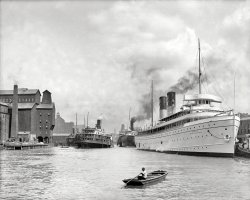
- Jocks in Socks: 1919
- Sept. 20, 1919. "Potomac Boat Club eight." National Photo Co. View full size.
Middle Boy I ... my tent at midnight.
Trained Now all they need is a boat.
I can't decide I'll take 1, 2 and 5!
Middle Boy He's ... Handsome Rakes?
Eight is enough Because "Potomac Boat Club Nine" just didn't have the same ring to it?
[The "eight" are ... Posted by Dave - 08/09/2012 - 11:55pm -
![Jocks in Socks: 1919 Sept. 20, 1919. "Potomac Boat Club eight." National Photo Co. View full size.
Middle BoyI want him bathed and brought to my tent at midnight.
TrainedNow all they need is a boat.
I can't decideI'll take 1, 2 and 5!
Middle BoyHe's really the only one who doesn't look like he broke out from some type of facility
To each her own, but--The boy in the middle is by far the hottest. Wowza!
PenultimateNext-to-Last looks a little uncomfortable with Mr. Dark Eyes behind him.
WOWWhat a fit looking group of guys!
Interlocking, yes.But to what extent?
Star materialLove the Superman wannabe costumes. Were there capes?
Dorks on a dockThey can't help how awful the uniforms are. Actually, they're all kind of cute; even Mr. Pince-Nez and Mr. Mustache aren't half bad. I agree with the other ladies about Mr. Middle, but since he reminds me a lot of my dad, I can't get excited about him. The fellow on the end looks like he's trying to compete with Rudy Valentino. He wins the trophy for Most Smoldering. Handsome Rakes?
Eight is enoughBecause "Potomac Boat Club Nine" just didn't have the same ring to it?
[The "eight" are the rowers. Plus the coxswain, with the megaphone. - Dave]
Ladies?Not that it matters -- nor do I have anything against anybody regarding their sexual preference, I am really curious how many of the previous posters ogling these young men are actually women.
Matt DamonThat's who the feller in the very back makes me think of.
De Feet Those socks should be a turnoff for any of the ladies who may be watching.......
I have to ask the obviousAnd that is why are they wearing socks?
Number 3It's Harold Lloyd!
Why the socks?There's a reason they're called "crew socks," you know!
Hausfraus?Yeah I'm with you -- at least lie and stick a name in there besides "Anonymous Tipster". Bleh
Crew SoxSocks are a necessity for crew, at least nowadays (and presumably back then too, unless the mechanics of strapping oneself into the rowing shell have changed considerably) -- you're tying your feet into shoes attached to the boat, undoubtedly full of smells and mold and other icky things, and then, pushing and pulling the oars, you're anchored only by those shoes! Without the socks, much chafing would occur (actually, it occurs anyway) and who knows what kinds of skin conditions would be picked up!
Ogling female hereI'll take the the Rudy Valentino lookalike.
I wonder how many of the guys' mothers scolded them over the condition of their socks when they saw the photo. And why did they leave their socks on, anyway?
Rrrroowwwrr!I am definitely female and can only say, "Give me allll of them. NOW."
Oh Brother>> I am really curious how many of the previous posters ogling these young men are actually women.
Really? You have doubts that those of us saying those men are hot are really women? Seriously? Do you know what year it is? 2009 and women are allowed to have sex drives now and appreciate a fine piece of tail (even if the pic is old).
Make Mine Middle-BoyAnd yes, I'm a female. When you other ladies are through wlth Middle-Boy, please send him to my quarters. I wonder if he's an ancestor of the also-adorable John Linnell of They Might Be Giants, whom he very closely resembles.
Sox Redux>> you're tying your feet into shoes attached to the boat
I had no idea the shoes were attached to the boat and wonder how many others knew that. Hope they were easy to slip out of in case one had to abandon ship.
Crew and ShoesBack in the old days-- which is to say, up into the mid 1970s or so-- the "shoes" consisted of a wooden "sole" with a metal heel cup and a canvas or leather "upper" which laced up around the ball of the foot. Getting out of this was easy enough if for instance you "caught a crab" (got the oar turned around a stuck in the water) and were thrown out of the boat. In the '70s we starting seeing running shoes attached at the ball of the foot to the sole plate instead. I never rowed much in a boat that used those, so I can't say much for their escape possibilities. Either way we always wore socks, which, getting splashed etc., tended to look just about as bad as these guys' do (except for the fellow with the mustache, who looks as though he has on a pair of Gold Toe dress socks).
Crew shoes, Part 2To follow up on CGW, shoes must have a 'heel-tie' now, a string attaching the heel to the boat. It lets the shoes flex, but only to a certain point, in case a rower has to pull his feet out quickly.
Ew, please!I have no problem ogling, then or now - and I can honestly tell you not ONE of them floats my boat! Pun intended. (Well, perhaps #5 - but I've got a thing for blonds). And I ain't no lady, and not shy to tell ya.
(The Gallery, D.C., Natl Photo, Sports)](https://www.shorpy.com/files/images/33383u.thumbnail.jpg)
- Sternwheeler Staples: 1910
- ... advertising and even signatures. -tterrace]
River boat operations There's no more entertaining way to learn about the details of river boat operations than to read the first half of Mark Twain's Life on the ... Posted by Dave - 06/18/2014 - 7:21am -
![Sternwheeler Staples: 1910 Circa 1910. "Packet steamer Jas. T. Staples." 8x10 inch dry plate glass negative, Detroit Publishing Company. View full size.
Dramatic Demise of the StaplesBuilt in 1908, the ship could carry a cargo of 2500 bales of cotton. It was owned by Captain Norman A. Staples, son of James T. and Mary Staples. Staples ran into financial problems in 1912, and his creditors took possession of the ship in December 1912. Staples then took his own life with a shotgun on January 2, 1913. One week after his death, on January 10, 1913, his former steamboat was destroyed in a boiler explosion about four miles away from where Staples was buried. Twenty-six people were killed and twenty-one injured in the disaster.
Survivors?Did any of those wooden stern wheelers survive?
Or at least the complete engine installation? In some museum or other?
No Juleps?That's a strikingly different view of steamboat travel -- actual utilitarian work, transporting freight. Belies the romantic notion of white-suited gentlemen sipping sloe gin. I think I like this view better.
Ghost StoriesThere was a wonderful commentary about the ghost of Captain Staples being seen on board the steamboat back in 2010.
Low in the waterI'm always amazed at how so many of those riverboats rode so low that their open, bottom decks appear to be only inches above the water line. Did they never encounter any water with the least amount of turbulence, even on the very broad rivers that might be whipped up by strong winds?
Hull DesignOlympus 2313 I've wondered the same thing about water coming aboard these steamboats. I have no doubt that they ran into plenty of rough water on the big rivers but if you take a close look the design of the hull, which is flared to throw the water away from the vessel and the overhang of the main deck which would further prevent water from coming aboard, I'm guessing that they were remarkable dry in spite of having such low freeboard.
DraftThey also had very shallow draft, and wooden construction was amazingly flexible. They could ride over 'most anything.
Of course, the ability to read the river and the weather made all the difference between a successful pilot and one who was less than successful.
Character limit?Wonder what they thought was gained by the elimination of the letters m and e from the name James. If they needed the room, perhaps use a smaller font size or lose the period at the end of the name. What kind of a computer were they using anyway?
[At the time, "Jas." was the common and familiar abbreviation for James. Frequently seen in signs, advertising and even signatures. -tterrace]
River boat operationsThere's no more entertaining way to learn about the details of river boat operations than to read the first half of Mark Twain's Life on the Mississippi. I mean, read it ALL, but in the first half he gives a lot of details about how river boats (and the river!)worked. It makes these river boat pictures all the more fascinating to study.
Wooden stern wheelers survive?Responding to StephanJ or anybody else interested in old steamboats: check out the Arabia Steamboat Museum - the engine and thousands of objects on display -very interesting time capsule
(The Gallery, Boats & Bridges, DPC)](https://www.shorpy.com/files/images/SHORPY-4a16144a.thumbnail.jpg)
- Monongahela: 1910
- ... tar and oakum were used to fill the various gaps in the boat's hull. Steamboat hulls were quite flexible in order to go over sandbars, ...
The Sunshine was built in 1888 as a ferry and excursion boat that operated in the Louisville area until 1907. Moved to Pittsburgh and ... Posted by Dave - 08/02/2012 - 4:15pm -
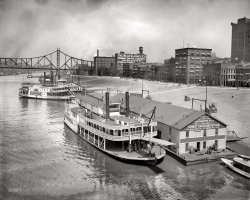
- Captain of the Guards: 1905
- ... People were very frank in a way back then.
If I Had a Boat Is Lyle Lovett's family from New York?
One day son Note the ... Posted by Dave - 08/05/2012 - 1:33pm -
![Captain of the Guards: 1905 New York circa 1905. "Capt. Riley and lifeguards, Coney Island." No horseplay or swooning allowed. 8x10 glass negative, Detroit Publishing Co. View full size.
Reilly Really Riley. Really.Thanks Dave, my oops. Indeed, he was Thomas J. Riley, as correctly reported in the NY Times article of 1898, and in the LOC photo file. However, he was also misidentified in other Times articles as Reilly, for example in the 1902 story about missing men who may have drowned. I managed to get confused about which spelling was really correct, and chose the wrong one. Here's a clipping from one of those "Reilly" articles. As for the $300, the type was rather broken, and I misread it. My oops again. Even $300 was a huge wage in 1898.
By going back to look again, I found a half-page biographical feature on Capt. Tom Riley, with artwork and a photo, published July 16, 1905.
[These are all quite fascinating. A big Shorpy round of applause. Clapclapclap! - Dave]
Photographer's note to self.Too many shots of fit, attractive people; get group shot of the Homely ones before leaving.
Professional Perils of LifesavingCapt. Thomas J. Reilly, captain of the life-savers at Coney Island's Balmer's Pavilion, was a former champion swimmer whose career as a life-saver earned him several notices in the New York Times. He was credited with saving the life of a man who nearly drowned in 1901. More sensationally, Reilly was fired and later regained his job in 1898, when he was blamed for laxity that was thought by his employers to have resulted in the supposed drowning of Miss Louise King, a wealthy young woman whose distraught personal maid reported her disappearance on Sunday, September 11, 1898. The maid, Alma Lindstrom, was described in a story dated September 28 as "an ignorant but honest Dane."
It turned out that Miss King had fooled her maid and had faked her disappearance in order to elope with her fiance, and she turned up a few days later as Mrs. S. Lloyd Chamberlain of Philadelphia. Capt. Reilly, still in disgrace, eventually sued her for damages in November 1898, having lost his $800-per-month position as a result of her little ruse. He did at least get his job back.
In August 1902, Capt. Reilly and his team were mentioned again in the news during another questionable set of drowning disappearances of two men on the same day, only one of whom may have actually drowned, while the other was thought by police detectives to have faked his death for undisclosed reasons. That article named two of Capt. Reilly's assistants, John Carroll and John Vogelstein, whose post was a rowboat near two anchored rafts in 14 feet of water.
[A great story, but I think the name is Riley, and he made $300 a month, not $800, according to the New York Times. - Dave]
Comments we won't see.Such as: not one person in this photo is overweight.
At least two of these guys could serve as flotation devises!
OMG will you look at the size of that guy's arms!
Put out that smoke before you jump in!Like the portly lifeguard with the cigarette!
Guinness is good for you!Looks like some of my relatives are mixed in there. However, I think most of the Quinns, Gormleys and Burkes were already established at the "Irish Riviera" -- Rockaway Beach, several miles east of these folks.
Skip ... per!That fellow in the captain's hat sure is a wee bit portly, eh?
Life Guard Large and In ChargeThus proving American obesity is not necessarily a recent development (nor, for that matter, is form-fitting swimwear, at least for the men). I would, however, love to have a swimming outfit, complete with black stockings, such as that worn by the woman at the right edge of the picture.
Zat' you George?Could that be George C. Tilyou smiling there in the middle?
Sink or swim!Imagine that -- an obese lifeguard who's smoking! No thanks. Just throw me the life preserver.
Don't smoke and swim!I love the cigarette in "The Captain's" left hand! Coney lifeguards were still taking group photos into the early 1960s. This one is inspiring!
Baywatch, 1904Need I say more?
YesI looks like the good Captain has remained true to his heritage. A slow pour, please!
Come now!The fat fellow is perfectly fine and looks ready willing and able to float out and save a life. The rest of them are fine too. People were very frank in a way back then.
If I Had a BoatIs Lyle Lovett's family from New York?
One day sonNote the young lad to the left looking a bit peeved due to the fact that those guys have ALL the girls around them. Ah, to live the life of Riley.
(The Gallery, Coney Island, DPC, Swimming)](https://www.shorpy.com/files/images/4a21447a.thumbnail.jpg)
- Baby Picture: 1908
- ... more except by social historians.
The original Love Boat The 1904 steamer trip with future president Taft where the couple met ... Posted by Dave - 09/12/2011 - 7:10pm -
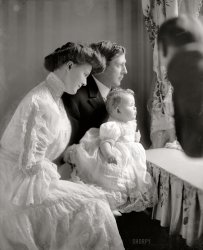
- Syracuse Boathouse: 1914
- ... wearing socks and no shoes because the shoes are in the boat. In crew you tie your feet right into shoes or shoe-like footholders that are built into the boat.
[Then why are the rowers in all the other crew photos wearing ... Posted by Dave - 07/29/2012 - 6:33pm -
![Syracuse Boathouse: 1914 1914. "Syracuse Varsity crew team at boathouse." Bain News Service glass negative. View full size.
No need for shoes......they're wearing socks and no shoes because the shoes are in the boat. In crew you tie your feet right into shoes or shoe-like footholders that are built into the boat.
[Then why are the rowers in all the other crew photos wearing shoes? - Dave]
backgroundThe vessel in the background, at about 3 o'clock, appears to be a ferry boat, the kind that carries automobiles...see the pilot house up high.
RowersIn my rowing days (actually the sixties of previous century), you had two systems in the boat: you had a "universal" system, where there were kind of straps with which you fasten your own shoes, and a more sophisticated one with shoes actually fastened to the so called "foot board". The problem is of course the size of the shoes. So, if a specific crew is the only user of a boat, you could have the shoes fixed on the foot board in the boat. If you have a boat that is used by many different crews you might prefer only straps.
Below an illustration.
By the way, also if you have fixed shoes you might use your own shoes to walk with the boat to the water, and leave your shoes either in the boat or on the quay. Some people might walk on their socks, but then you risk to get wet feet! But also if there are no fixed shoes, some rowers prefer rowing without shoes.
Therefore you may see rowers with and without shoes outside the boat, as you could see on the photograph of the Penn varsity crew team, 1914.
(The Gallery, Boats & Bridges, G.G. Bain, Sports, Syracuse)](https://www.shorpy.com/files/images/SHORPY_16286u.thumbnail.jpg)
- Dog, Paddle: 1942
- ... size.
Abandon Ship? Looks to me like this little boat is taking on water, since Mr. Hall's foot is submerged. One hopes they're ... Posted by Dave - 04/26/2023 - 2:35pm -
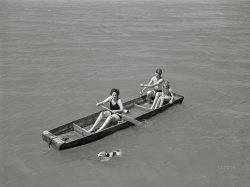
- The Kraken: 1942
- ... it to Edgar Goff in 1944 who converted it to a fishing boat. Remarkably, it endured for almost another quarter century owned by Goff ... are painters. Black cap runs the engine and pilots the boat. But if they're about to paint the Kraken, why haven't they pulled her ... Posted by Dave - 10/10/2022 - 10:55am -
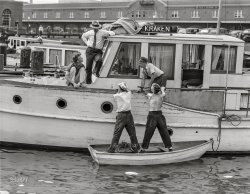
- Marblehead Marinara: 1906
- ... is the view today. The terrain matches and the private boat dock at right is in the same place. If you look behind you, you'll see the ... Posted by Dave - 02/22/2023 - 1:21pm -
![Marblehead Marinara: 1906 Circa 1906. "Glimpse of harbor. Marblehead, Massachusetts." 8x10 inch dry plate glass negative, Detroit Publishing Company. View full size.
Still very scenicThis is the view today. The terrain matches and the private boat dock at right is in the same place. If you look behind you, you'll see the Eastern Yacht Club. It looks like it was there in 1906.
Idyllic with an asteriskMarblehead today is a lovely destination for an afternoon, with (in its own words) "quaint narrow streets and historic 17th and 18th century buildings [that] mirror Marblehead as it has existed since its founding in 1629."
Also, not surprisingly, one of the wealthiest places in our second richest state. Its historic industries of commercial fishing, shoemaking, and aircraft manufacture have been replaced by yacht clubs and tourism. After World War II it became a bedroom community, and by 1970 was "built out." Though its website emphasizes diversity, its population of 20,000 is more than 95% white, with a median household income over $150,000 and a poverty level below 3%. It's one kind of American story.
Maine Class BattleshipThe US Navy warship on the far right (partly obscured) looks to be a Maine class battleship, probably the Maine herself (BB10) (the second one, not the one that exploded in Havana in 1898) or perhaps the Missouri (BB11). Either way, she is resplendent in her peace time colors of buff and white and must have looked a treat on this beautiful day. In December of 1907 this ship will set sail as a part of Teddy Roosevelt's Great White Fleet.
Spaghetti Sauce Slip?Are we sailing or having tagliatelle?
[Marinara is Italian for "seafaring." In a pasta context, "sailor-style." - Dave]
Marina is already Italian (and English) for marina.
Maybe not so idyllicLurking far away in the extreme right center, there appears to a large steamship with three funnels and fore and aft tower structures. In 1906 the most likely suspect of that configuration (especially considering the area) would be the USS Connecticut (BB-18) Pre-Dreadnought Class Battleship.
Georges SeuratIt immediately suggests "A Sunday Afternoon on the Island of La Grande Jatte," probably because of the trees and the shade.
Tree Of KnowledgeI need the learned Shorpy family to educate me about what the seemingly cloth bands around the trees are. I have never seen anything like that before. Thanks in advance.
[Traps for the larval stage of the gypsy moth, which first arrived in the United States in Massachusetts in 1869. - Dave]
Thanks so much Dave. Never too old to learn something new!
Postcard KodakIt looks like the fellow on the left may be holding one of the recently introduced "Postcard Kodak" cameras. The format allowed printing your photos in the dimensions of the extremely popular postcards.
Burlap WrapsAlso found in this photo.
https://www.shorpy.com/node/14800
MemoriesMy mom was born in Marblehead and I spent many summers there. The picture is from the "Neck." We used to love to visit the castle that was on the seaside of the peninsula.
(The Gallery, Boats & Bridges, DPC)](https://www.shorpy.com/files/images/SHORPY-4a12929a.thumbnail.jpg)
- Tashmoo Too: 1901
- ...
Springline Magnificent boat!
The photo demonstrates a once standard method of ship handling, the ... run from a cleat at the stern to a dock piling. The ship ("boat" on the Great Lakes) then "backs against the spring", pulling the stern ... and causing the bow to swing out into the river. The boat had been docked in the nearer curved slip, and at this point has been ... Posted by Dave - 08/02/2012 - 3:16pm -
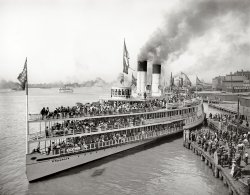
- Chrysler Building: 1932
- ... to NYC Many years ago my father took me to NYC for the boat show and we walked for miles seeing the sights. He took us to Macy's, St. ... Posted by Dave - 07/31/2012 - 2:52pm -
![Chrysler Building: 1932 Jan. 19, 1932. "View from Empire State Bldg. to Chrysler Building and Queensboro Bridge, low viewpoint." 5x7 negative by Gottscho-Schleisner. View full size.
For a moment...I was wondering where the Empire State Building was! Then I read the caption. What an amazing photo this is. Dave, you're outdoing yourself lately. Gottscho's negatives are a true treasure.
Is this backwardsHas this photo been mirrored? The empire state building is to the southwest of the Chrysler building, which is southwest of the bridge.
[Whoops. It was backwards. Now fixed. Thank you! - Dave]
Welfare IslandThe Queensboro Bridge that connects Manhattan to Queens is seen straddling Roosevelt Island, a residential community of some 12,000 people. There are rentals, co-ops, and condos and it is a self contained community with some of the best views of Manhattan. Its predecessor was called Welfare Island and housed the city's tuberculosis hospital, before that it was known as Blackwell's Island, which was a prison complex and insane asylum. Roosevelt Island is connected to Manhattan by a tramway (59th Street) and a newer subway station (IND on the 63rd St Line). It can be approached by car or truck from the Queens side. The founders fought hard to make it part of Manhattan and not Queens, it has a Manhattan Zip Code, 10044, and Area Code, 212.
Speaking of directionsIsn't that the Sydney Harbour Bridge out in the distance in the top-left corner?
Great work DavePlease keep the NYC views coming, They have been great. This one is my new desktop wallpaper. Thanks for your tireless efforts.
[You're (pant, gasp) very welcome! - Dave]
Negative CommentIs the negative reversed here? It seems like the East River should be on the right, not the left.
[Maybe it's the West River. - Dave]
[Thanks for fixing it! Can you switch faucets, too? My hot is cold and my vice is versa.- Delworthio]
Same ViewpointI believe I snapped a photo from the same viewpoint at Mr. Gottscho 70 years later on the occasion of my 40th birthday - November 1, 2002.
Why, why, whyWhy, why, why is this picture so much more beautiful and magical and fascinating and dreamy than your average cityscape of today on film? Is it gothic/nouveau/art deco subject matter + the technique + the hardware? I don't know, but I sure love it.
Equal TimeWashingtonians have had their day for quite some time now and New York is having its day in the sun, thanks to Dave. Can San Francisco be far behind?
What happen?When I look at the magnificent architecture of these old pre-1950 buildings and compare them to the unimaginative glass boxes of today- I wonder- what happen?
My first visit to NYCMany years ago my father took me to NYC for the boat show and we walked for miles seeing the sights. He took us to Macy's, St. Patrick's, Radio City and the top of the Empire State Building. Somewhere I have snapshots from the observation deck, all four directions at that. I'll have to find them and see how they compare.
GasometersThe gas holders by the bridge caught my eye. I didn't realize how huge they are - a lot of the nearby buildings could fit inside one.
Similar tanks were pictured in this previous post.
It was positiveThe canyons of mid-Manhattan were places of positive joy for a early 20-something guy attending television and radio production school at RCA Institutes in 1963. At the time I held a grand position as mail boy in the then-General Electric Building at 570 Lexington Ave. (to the left behind the Waldorf Towers in the photo), and my dad had an office in the Empire State Building at the time. Apropos of nothing, I once saw Van Johnson striding down Broadway in a trench coat walking a brace of Afghan hounds. Ah, those truly were the days, my friend!
Re: Speaking of directions>> Isn't that the Sydney Harbour Bridge out in the distance in the top-left corner?
Kind of, it's the Hell Gate Bridge, which turned out to be an inspiration for the SHB. Also seen here on Shorpy.
Another stunner!Another stunning view. And just when I'd thought I had found my favorite Shorpy picture....These cityscapes always blow me away. KEEP "EM COMING!
Amazing!This is my new wallpaper, replacing the Detroit Aquarium. The 59th St. Bridge has never looked so good. Frustratingly, my neighborhood in Queens is just to the right of the frame. I got a kick out of seeing both the 3rd and the 2nd El's in the lower right corner. These have both been torn down now. You can read about them here.
Re: White CastleNew York Hospital. Now Weill Cornell Medical Center.
EvocativeWhen I look at this photo (and the other Gottschos), it summons up a lifetime's worth of emotion in viewing the astonishing landscape of the Capital of the World and I am yearning again for a city that has no equal anywhere. And to echo the tenor of several of the commentators, this period in time was perhaps the New York era ne plus ultra.
Thanks again, Dave.
What's that cool building?What's the building about a block to the left of the Chrysler building, with gothic arches near the top and what appears to be a penthouse with skylight? Is it still standing?
The current viewYou can almost duplicate this view using Google Earth's 3D buildings feature. The building in the lower left is the Mercantile building, finished in 1929. The building with the gothic arches is the Lincoln Building and still stands.
Cool Lincoln BuildingThe "cool" building with the Gothic Arches is the Lincoln Building at 60 East 42nd Street. I used to work in it.
And yes it is still there!
Seen clearly in this viewSeen clearly in this view are the towers at 295 Madison Avenue (SE corner of 41st Street) and 230 Park Avenue (now the Helmsley Building, between 45th and 46th Streets), the latter of which is surrounded by the east and west ramps of Park Avenue, as are the Met Life (once the Pan Am) building and the Grand Central Terminal complex. I worked at 295 Madison in 1959-60, and later at 230 Park in 1977-1981. It's great to see these classical skyscraper buildings again, and to hope they are never demolished for one of those glass monstrosities so prevalent today in this part of Manhattan.
Perfect TimingBy coincidence, the Knowledge Channel here in Canada has recently been re-running Ric Burns's excellent documentary "New York." Watching the series again and seeing these great images on Shorpy is perfect timing. I can almost hear the splendid narrative of the documentary in my head as I gaze upon these wonderful photographs. More please!
White CastleCan anyone identify the big gleaming complex on the river, north of the bridge? I'm guessing its around the E 70s. I can't spy anything like that in Google Maps or Earth and it seems like a mighty big object to disappear. Maybe it was in Robert Moses' way when building FDR Drive?
[It's still there. New York Hospital. - Dave]
The City is beautiful, but..I've been waiting to make a comment on the recent string of NYC photos. I grew up on Long Island and could see lower Manhattan from my school's playground. I always wanted to know what the skyline looked like before my time.
That said, the hardest thing for me to realize is that although this view is absolutely stunning, it was taken at the height of the Great Depression. I cannot reconcile the stories of suffering and privation that led to my grandfather running away from his home not too far uptown from here and only four years after this picture was taken (at age 14) with the gleaming monuments to mankind that compose this photograph.
SurroundedAhh, I see it, thnx. Wow, the neighborhood really grew, it doesn't stand out as much.
The cool building is...
The Chanin Building. You can see it in the 2002 photo I posted below.
[Actually the "cool building" referred to below is the Lincoln Building. - Dave]
Old pics vs new pics>> Why is this picture so much more beautiful and magical and fascinating and dreamy than your average cityscape of today on film? Is it gothic/nouveau/art deco subject matter + the technique + the hardware?
A good question, not easy to answer-- but some people still take above-average cityscapes, e.g.
http://www.pbase.com/rfcd100/image/83470981/original
Gigapans from this viewpoint...Hi -
I just completed a series of view from the Empire State Building. Can't really embed any of the photos, as they are several hundred megabytes each (10MB images stitched together), but here is a link with a view of the Chrysler Building. If you want more, simply search the gigapan.org website for my pictures (search for "JohnF" there), there are a number of them from New York and elsewhere...
http://gigapan.org/viewGigapan.php?id=30511
John
Legos or a Video GameI love this photograph. At first glance it looks surreal, like it is a Lego block building set or a video game where you build a city empire.
(The Gallery, Boats & Bridges, Gottscho-Schleisner, NYC)](https://www.shorpy.com/files/images/05841u_0.thumbnail.jpg)
- Young Granddad: 1963
- ... comments about my grandpa, but hey, whatever floats your boat!
My grandpa was (and still is) a chief engineer on tuna boats.
My ...
To put it bluntly, he's the guy who makes sure boat engines run well enough so you can have a tuna sandwich.
Re: I cringed ... Posted by Tony W. - 09/17/2011 - 8:08pm -
![Young Granddad: 1963 This is my dad as a toddler with Grandpa washing the car, probably around 1963 in Los Angeles. Scanned from a Kodak safety negative. View full size.
Hunky GrandpaSimply cannot ignore this perfect-looking gent. This appreciative female thanks you for remembering that ladies enjoy a gorgeous view, too.
Hubba HubcapHey, Grandpa was good lookin'!
A choice specimen indeedThe Volvo, I mean.
PLCF CenterfoldThe Rambler, the Volvo, Junior's sandals -- this could be cover art for the Summer 1963 issue of Progressive Left Coast Family. What did your dad end up doing as a grownup? What was Granddad's line of work? A great photo, very evocative.
A Rambler *and* a VolvoWow, a Rambler Classic, *and* a Volvo (looks like a 544) in the same driveway. And your dad is about my age (49). Great picture. Thanks for sharing this one, Tony. When I was a kid, my parents owned a Rambler, and my dad was always fascinated with Volvos, mainly the 122.
Wow!Reminds me of Don Draper. Yum!!
OH MYGrandpa looks mighty fine!
They don't make 'em like that anymore!Chain link fences that is... Notice the top of the fence. Those barbs opened up the wrist of my friend when we were kids back in Newark NJ in about 1960. There were hedges behind the fence and he reached over while passing by on his bike to pull off a leaf. Zzzziiippp. Several hours and a spools worth of sutures and he was okay. Thankfully, fence tops are folded over now.
Gangster WhitesI had just gotten my driver's license in 1963 and I remember cleaning whitewalls with a Brillo pad, just like Grampa is doing.
ApexThe absolute apex of American civilization captured in this photo. That's it folks. It'll never happen again.
And for dessert I'll haveAn order of beefcake, circa 1963!
Hubba hubba!Grandpa can hang his hat at MY house ANY time!
I cringedIt's odd to read all these lustful comments about my grandpa, but hey, whatever floats your boat!
My grandpa was (and still is) a chief engineer on tuna boats.
My father also became a chief engineer on American tuna boats, first starting in San Diego and then moving to American Samoa. Now he works in the ports and gives his wealth of knowledge about engines to other engineers.
To put it bluntly, he's the guy who makes sure boat engines run well enough so you can have a tuna sandwich.
Re: I cringedThe cougars do get restless around twilight -- if you don't turn your back on them you'll be fine. My favorite thing here is the bright yellow hose on the green lawn. Something tres Sixties there. You have a good eye for interesting pictures.
Pago PagoGreat photo. I probably know your dad (and granddad) as I was here in Pago during the great purse-seiner days of the late 1980s and through the 90s.
There are about 23 boats operating here now. Some New Zealand. With Samoa Packing closing down that number may diminish.
From Pago Pago,
John Wasko
Yellow HoseSeeing the yellow water hose reminded me of how my father and uncle, back in the 50s and 60s, would never buy common "garden hose" (like we still have) because it wore out much too quickly. One kink and it's dead.
Rather, they would buy low pressure air hose, like the kind used in gas stations. Ten minutes with a hammer and you had a sturdy hose, typically yellow or a dull red, which was probably 25 percent more expensive but would last for years. I still have one I made back in the 70s and use often.
HVAC UpgradeNote the window A/C next door. These "breeder boxes" were built hurriedly (but solidly) throughout SoCal by the hundreds of thousands in the years following WW2.
Built-in A/C was a practically unheard of option in these houses, but by 1963, even my grandparents had it (courtesy of Sears). My gramp got spiffy and cut a hole in the wall for their unit.
Grandpa was such a beefcakeI bet the son and the grandson became great hunks too !!
Perfect sandals!Love the sandals on the toddler! Those were the days when sensible people designed sensible summer footwear for children--not the slide-ons you see today.
HotnessI sure am glad it was a hot day!
There are plenty of things I could say right now...But I think a dreamy sigh will suffice.
Stylin'I love how the baby looks so ...tidy. His hair was parted and combed over, just to go outside with Daddy and wash the car. For a candid snap, this is remarkably poised.
One more thingI wanted to make one more comment. Someone mentioned above that this reminded them of the "apex of American society". Interesting in that if you look at how most Americans lives back in the 50's and 60's, the typical family had a house that was around 700 square feet, a single car, and a single TV set. My mother along with most everyone else in my family grew up in small houses like those shown in the picture. They also shared rooms with their siblings.
Look around today and the typical family home is over 3,000 square feet, there are at least 3 cars in every driveway, at least 2-3 TV sets ( flatscreens) at least 2 computers, a cell phone for every family member, an abundance of shoes and clothing which are bought as cheap disposable items at big box stores, and other endless forms of entertainment. Yet when people speak of "the good times", somehow we always come back to this single era. I think that says an awful lot about the lack of appreciation people these days have for what they've got. My grandparents went through the depression and WW2. 15 years of pain and suffering. You had better believe they appreciated everything they had after it was all over. Even today with the worst recession in decades, I doubt most Americans come close to that level of appreciation.
TouchingI LOVE this picture. it really put a smile on my face for so many reasons.
The Good Ol' DaysGregg Easterbrook wrote a book, "The Progress Paradox," discussing how people in the U.S. and Europe today are living better than their parents ever did, yet aren't any more happier. Just because we have more things like cell phones, TV's and cars, doesn't make life truly any better. OTOH, if you asked the people of the period in this picture if they thought this was the Apex of American Civilization, you may get a surprising answer. They may have thought life was so much better back in the Twenties or something, where they didn't have to worry about Communist missiles, civil unrest, or atomic radiation causing giant ants to run amok.
And yes, Grandpa is mighty fine. Mighty fine. Is he still alive? Is he aware of how much drool he's engendered?
P544I had a P544 bought new in 1964 with the only options available, a $5 side mirror and a $35 AM radio, $2,050 complete.
A VW at the time sold for around $1,295.
Had to crack open a window to close a door, airtight.
The 122 was nice as well, but the P444-544 was a true classic.
Young father and grandfather!If the toddler is your father in 1963 he married VERY young to have you! And you are very young.
[His dad could have been around 40 when he got married. If you click on Tony's profile you'll see that he is 18. - Dave]
Color MagicI love Shorpy. Work today was very slow so, um, I sorta spent the last half-hour Shorpy-ing. The older, b&w photos are intriguing but it's these color images from the 1960s that have really caught my imagination today. Color just sorta has a "you are there" effect!
So, anyway, thank you Tony and TTerence for sharing these! And, I know you think this is weird Tony, but I have to agree that Grandpa was/is mighty fiiiiiine!
'61 Rambler, 60-something P544My parents also had this same combination of cars, a '61 Rambler and a 1960 Volvo P544. I think the Volvo cost about $1800.
You are fortunateI love this picture, I was admiring all of the details and your grandfather was quite a handsome man. I was never fortunate to have met either of my grandfathers, so I am quite jealous. It also takes me back to my childhood.
GrandpaOh why do we have to get old.
SurprisedI just looked around this site, first I saw my mother (Baby Shower 1960). My kids laughed and said look at the rest, Dad! I am the kid with the yellow hose, cowboy tricycle etc., and this is my dad. Ladies, you are right! He was, and still is, a "super hunk" -- 72 now, and I am 49.
Great job son,
Love Dad
Oi!Now that's a real life Charles Atlas!
(ShorpyBlog, Member Gallery, Handsome Rakes, Tonypix)](https://www.shorpy.com/files/images/WashingtheCar_0.thumbnail.jpg)
- Bathing Beauties: 1919
- ... invented.
Hubba Hubba I'd like to be on a slow boat to China with the one holding the oar.
1919 Cheesecake The gal with ... that uses the phrase "Hubba Hubba" would find the slow boat to China not slow enough.
Well built Considering that there are ... Posted by Dave - 02/02/2016 - 8:44pm -
![Bathing Beauties: 1919 Washington, D.C., circa 1919. "Sennett girls." Producer Mack Sennett's comedy reels featured a bevy of "bathing beauties," among them Marvel Rea, seen here in the harlequin costume. National Photo Company. View full size.
That's the kinda stuffthat'll get the neighbors talking! haha
Wicked witch of the westor a chaperon at the left of the frame. Maybe both ??!!
Racy stuff for 1919Some of these swimsuits are pushing the envelope of propriety for the year my grandmother married. Hollywood is still pushing the envelope ninety-two years later.
Will you look at that!Mommmmmm. Grandma is showing some nip again.
Lucky FellowThe dude with the boss set of wheels is taking them home to try them out.
Wowser!The lady holding was quite a looker with obvious assets.
Separate and UnequalHmmmm. Looks like the beauty holding the paddle needs a slight frontal adjustment to level things out. Obviously sport bras had not yet been invented.
Hubba HubbaI'd like to be on a slow boat to China with the one holding the oar.
1919 CheesecakeThe gal with the pillow on her head can't believe the size of the uh, oar.
Decorative doll The gal on the hood makes a great looking ornament!
Something to Await
Washington Post, Oct 19, 1919
Something to Await
All of Washington is looking forward to the arrival of the famous Mack Sennett girls, who are due to reach this city in the near future, and who are to appear every day on the stage at one of the local theaters in conjunction with the much-heralded feature photoproduction "Yankee Doodle in Berlin." This is Mack Sennett's greatest film, and is six parts, featuring Charlie Murray, Ben Turpin, Ford Sterling, Chester Conklin and Marie Provost. It will be a gala week all in all, and many novel entertainments have been planned for the benefit of the Sennett beauties. There is confusion gone riot out in California at the Mack Sennett comedy studio. When Mr. Sennett made it known that he would permit several of the bathing beauties to journey East and appear in person with "Yankee Doodle in Berlin" the whole studio went wild. Every girl wants to come. Mr. Sennett has to do business and has to make a certain number of films a year. If he were to assent to the demands of the bathing beauties and let whoever wanted to go make the trip, he might as well shut up shop during the engagement. But one thing is sure — whoever does come will be class.
Slower BoatsAnyone that uses the phrase "Hubba Hubba" would find the slow boat to China not slow enough.
Well builtConsidering that there are 1000 pounds of bathing beauties on that same side, I'm quite impressed that the car shows no effect other than the top of the tires being ever so slightly closer to the fenders. If you put 1000 lbs. on the left side of my Buick it would likely collapse.
Marvel Luciel Reahas to be in my top ten list of interesting names. I couldn't find much about her on the Internet. I read where she survived being kidnapped in 1936 and committed suicide in 1937. Besides the Wikipedia article, does anyone have any other websites that have additional information about her?
[Click on her name in the photo caption, then scroll down. - Dave]
Wowser! The sweet young thing holding the oar could paddle my canoe anytime.
Hood Ornaments of the Human KindThere seems to be an widespread early 20th century tradition of posing people on cars. Not next to cars, or posed as if driving cars (which was also done) but standing on the running boards and sitting on hoods, fenders, and other places people were not meant to sit. I don't get it.
Can you imagine mom and the kiddies all posing on the hood of a Toyota Camry? How about just junior and his seven friends on the Escalade?
So here is another photo with seven people physically on a car. What the heck is that about?
[It is a mystery, isn't it. - Dave]
I wonderWOW, I can't believe no one has mentioned Charlie Chaplin. I wonder if he'd met any of them just a few years earlier in his time with Sennett. Come to think of it, maybe they were too old for him, even then.
Barrymore to come? The girl holding the oar (I wish we knew more of these girls' names) always reminds me of Drew Barrymore; the face, the attitude and the (original) bust line!
It is sure obvious, looking at the evolution of beach attire from the photos of bathing beauties from the first quarter of the 20th century, that Hollywood always had a great deal of influence. I don't think Hollywood can push the envelope much further, though, as far as how much skin to show, unless they start covering something up.
Far rightI love the last one on the right, all in white. I'd have wanted to be her.
MysteryCorvette, what Corvette?
Modern women could learn from themThese gals are smokin'. Modern women could take lessons on how to be a beautiful curvaceous babe from them. Mr. Peabody fire up the time machine!
(The Gallery, D.C., Movies, Natl Photo, Pretty Girls)](https://www.shorpy.com/files/images/00876u.thumbnail.jpg)























